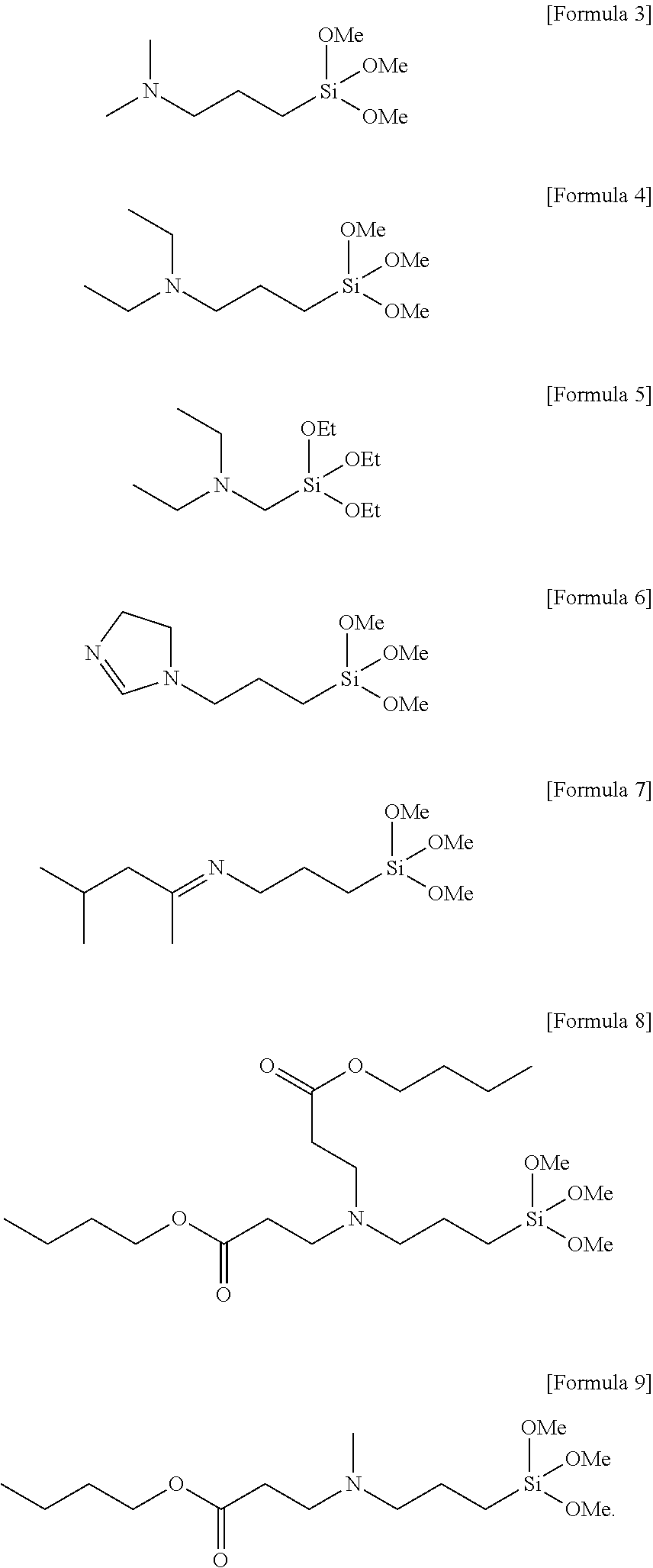Adhesive composition
a technology of adhesive composition and composition, applied in the field of adhesive composition, can solve the problems of peeling off and rebonding difficulties, and achieve the effects of reducing adhesiveness, excellent initial adhesiveness and adhesive durability, and favorable adhesiveness
- Summary
- Abstract
- Description
- Claims
- Application Information
AI Technical Summary
Benefits of technology
Problems solved by technology
Method used
Image
Examples
example 1
Preparative Example 1
Preparation of Acryl Copolymer
[0085]A monomer mixture including 85.4 wt. parts of n-butyl acrylate (BA), 7 wt. parts of methyl acrylate (MA), 5 wt. parts of 2-hydroxyethyl acrylate and 2.6 wt. parts of acrylic acid was introduced into 1 L reactor equipped with a cooling device for easy control of temperature, in which a nitrogen gas is refluxed. Then, a solvent, that is, 100 wt. parts of ethyl acetate (EAc) was added thereto. Next, after purging the nitrogen gas for 1 hour in order to remove oxygen, the mixture was maintained at 62° C. After homogenizing the mixture, 0.07 wt. parts of a reaction initiator, that is, azobisisobutyronitrile (AIBN) was introduced into the reactor, followed by a reaction for 8 hours to prepare an acryl copolymer (with a weight average molecular weight of about 1,000,000).
example 2
Preparative Example 2
Preparation of Acryl Copolymer
[0086]A monomer mixture including 90 wt. parts of n-butyl acrylate (BA), 5 wt. parts of methyl acrylate (MA), 4 wt. parts of 2-hydroxyethyl acrylate and 1 wt. part of acrylic acid was introduced into 1 L reactor equipped with a cooling device for easy control of temperature, in which a nitrogen gas is refluxed. Then, a solvent, that is, 100 wt. parts of ethyl acetate (EAc) was added thereto. Next, after purging the nitrogen gas for 1 hour in order to remove oxygen, the mixture was maintained at 62° C. After homogenizing the mixture, 0.07 wt. parts of a reaction initiator, that is, azobisisobutyronitrile (AIBN) was introduced into the reactor, followed by a reaction for 8 hours to prepare an acryl copolymer (with a weight average molecular weight of about 1,000,000).
example 3
Preparative Example 3
Preparation of Acryl Copolymer
[0087]A monomer mixture including 91 wt. parts of n-butyl acrylate (BA), 1 wt. part of 4-hydroxybutyl acrylate and 8 wt. parts of acrylic acid was introduced into 1 L reactor equipped with a cooling device for easy control of temperature, in which a nitrogen gas is refluxed. Then, a solvent, that is, 100 wt. parts of ethyl acetate (EAc) was added thereto. Next, after purging the nitrogen gas for 1 hour in order to remove oxygen, the mixture was maintained at 62° C. After homogenizing the mixture, 0.07 wt. parts of a reaction initiator, that is, azobisisobutyronitrile (AIBN) was introduced into the reactor, followed by a reaction for 8 hours to prepare an acryl copolymer (with a weight average molecular weight of about 1,100,000).
PUM
| Property | Measurement | Unit |
|---|---|---|
| thickness | aaaaa | aaaaa |
| thickness | aaaaa | aaaaa |
| thickness | aaaaa | aaaaa |
Abstract
Description
Claims
Application Information
 Login to View More
Login to View More - R&D
- Intellectual Property
- Life Sciences
- Materials
- Tech Scout
- Unparalleled Data Quality
- Higher Quality Content
- 60% Fewer Hallucinations
Browse by: Latest US Patents, China's latest patents, Technical Efficacy Thesaurus, Application Domain, Technology Topic, Popular Technical Reports.
© 2025 PatSnap. All rights reserved.Legal|Privacy policy|Modern Slavery Act Transparency Statement|Sitemap|About US| Contact US: help@patsnap.com



